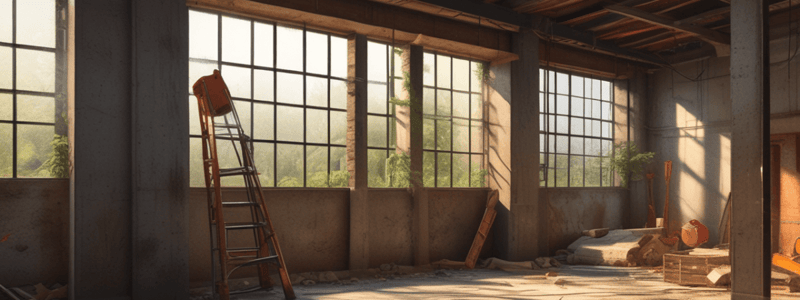Podcast
Questions and Answers
What is the primary effect of excessive moisture on building membranes?
What is the primary effect of excessive moisture on building membranes?
- Enhanced appearance and durability
- Improved dimensional stability
- Delamination, blistering, or leaking (correct)
- Increased thermal efficiency
How does excessive moisture affect the performance of insulation materials in buildings?
How does excessive moisture affect the performance of insulation materials in buildings?
- Insulation materials become more effective at maintaining temperature balance
- Insulation materials experience increased dimensional stability
- Insulation materials lose thermal efficiency and become less effective (correct)
- Insulation materials are unaffected by excessive moisture
What is the primary effect of excessive moisture on wood products in buildings?
What is the primary effect of excessive moisture on wood products in buildings?
- Increased resistance to decay, fungal attacks, and insect infestations
- Improved dimensional stability, leading to less warping, cupping, or twisting
- Reduced susceptibility to decay, fungal attacks, and insect infestations
- Increased susceptibility to decay, fungal attacks, and insect infestations (correct)
What is the primary effect of excessive moisture on metal building elements?
What is the primary effect of excessive moisture on metal building elements?
What is one of the key strategies for mitigating moisture issues during construction?
What is one of the key strategies for mitigating moisture issues during construction?
What is the primary goal of implementing moisture mitigation strategies during construction?
What is the primary goal of implementing moisture mitigation strategies during construction?
What is one of the primary consequences of uncontrolled moisture accumulation in buildings?
What is one of the primary consequences of uncontrolled moisture accumulation in buildings?
Which of the following is a typical source of construction-generated moisture from material manufacture and installation?
Which of the following is a typical source of construction-generated moisture from material manufacture and installation?
How can building systems contribute to construction-generated moisture?
How can building systems contribute to construction-generated moisture?
Which environmental factor can contribute to moisture redistribution through the building envelope?
Which environmental factor can contribute to moisture redistribution through the building envelope?
What is one potential consequence of using temporary heating and enclosures for curing and drying purposes during construction?
What is one potential consequence of using temporary heating and enclosures for curing and drying purposes during construction?
Which of the following is a typical source of construction-generated moisture from building materials?
Which of the following is a typical source of construction-generated moisture from building materials?
Flashcards are hidden until you start studying
Study Notes
Building Components and Moisture Issues
During the construction process, moisture is often introduced into a building, either intentionally or unintentionally. Uncontrolled moisture accumulation can lead to various problems, including damage to building components and the development of harmful microorganisms like molds and mildews. Moisture can originate from multiple sources and affect different building components in various ways.
Sources of Construction-Generated Moisture
Some typical sources of construction-generated moisture include:
Material Manufacture and Installation
- Use of water in manufacturing and installing concrete, brickwork, and plaster.
- Application of water-based products like paint and adhesives, which release water vapor during curing and drying.
- Evaporation of water from lumber due to hygroscopic properties.
Building Systems
- High water content in building materials like concrete, causing excess moisture after hardening.
- Combustion of propane in heating systems generating moisture, particularly in unvented temporary enclosures.
- Temporary heating and enclosures used for curing and drying purposes, potentially leading to significant moisture accumulation.
Environmental Factors
- Temperature gradients between indoors and outdoors, resulting in moisture redistribution through the building envelope.
- Relative humidity levels above 80% promoting microbial growth.
Effects of Excessive Moisture on Building Components
When moisture accumulates beyond control, it affects the performance and longevity of various building components, including:
Roofs and Walls
- Membranes can experience delamination, blistering, or leaking from excessive moisture absorption.
- Insulation materials can lose thermal efficiency and become less effective at maintaining temperature balance.
- Wall coverings may develop mold and mildew, affecting their appearance and durability.
Wood Products
- Increased susceptibility to decay, fungal attacks, and insect infestations.
- Reduced dimensional stability, leading to warping, cupping, or twisting.
Metal Building Elements
- Chemical reactions leading to electrochemical corrosion of metal features.
Mitigating Moisture Issues During Construction
To minimize moisture problems during construction, several strategies can be employed:
- Ensure proper ventilation and temperature control measures, such as temporary heating and enclosures, to allow evaporative loss and avoid condensation on building components.
- Utilize moisture-resistant materials or coatings when applicable.
- Monitor relative humidity levels within the building envelope during construction.
In conclusion, managing construction-generated moisture effectively is crucial for preserving the durability and longevity of building components. By recognizing the sources and effects of excessive moisture, and implementing suitable mitigation measures, stakeholders can work towards minimizing moisture issues in newly constructed buildings.
Studying That Suits You
Use AI to generate personalized quizzes and flashcards to suit your learning preferences.




